








What international businesses and
organisations
are doing to build a better










organisations
are doing to build a better
by Paola Bertelli
The first yacht to function on hydrogen generated from green methanol has just been launched. The energy produced will be used to power the 50Steel’s onboard services.
Aday to remember. Over 700 people attended the launch of Sanlorenzo’s new 50Steel last May during the yard’s 2024 Élite Days, an exclusive annual event that Sanlorenzo organises for its owners.
At 50 metres in length and spanning five decks, the 50Steel is the first yacht to be equipped with Reformer Fuel Cell systems powered by hydrogen obtained from green methanol and used for powering the yacht’s onboard services. This solution allows the 50Steel to produce up to a maximum of 100 kW with propulsion engines and diesel generators turned off.
The launch marks a key milestone in Sanlorenzo’s ‘Road to 2030’, the yard’s plan for the progressive reduction of its environmental footprint. The ambitious goal Sanlorenzo has set itself is to deliver the first ship with 100% carbon neutral propulsion by 2030.
The system, certified by Lloyd’s Register and produced by Advent Technologies,
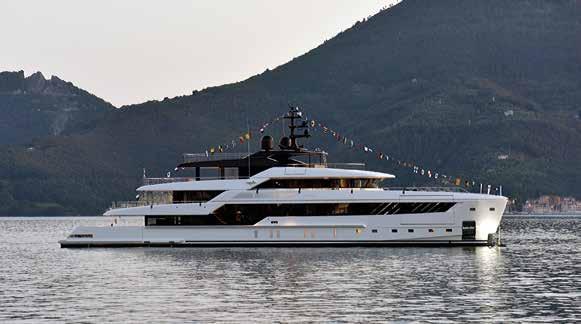
The launch of the 50Steel marks a key milestone in Sanlorenzo’s ‘Road to 2030’, the yard’s plan for the progressive reduction of its environmental footprint
Siemens Energy’s partner in the construction of this very system developed with Sanlorenzo, features a Reformer capable of both transforming green methanol into hydrogen and, through the Fuel Cells, powering all services onboard at the same time, all without actually storing hydrogen onboard, eliminating the associated risks.
The fuel cell’s only byproduct is water vapour, a harmless byproduct that is not released into the environment but rather, through a condenser, converted back into water, to be reused to produce the mixture
needed for the fuel cell, composed of 60% methanol and 40% water.
Sanlorenzo has focused on reducing emissions when the yacht is at anchor and not moving. After all, according to data collected by the yard, for 90% of the time spent on board, yachts are generally stationary. Sanlorenzo emphasizes how the introduction of this system has the potential to reduce emissions by 20-30% on an annual basis, anticipating by as much as six years the recent IMO strategies that include an obligation to reduce emissions by 20% before 2030.
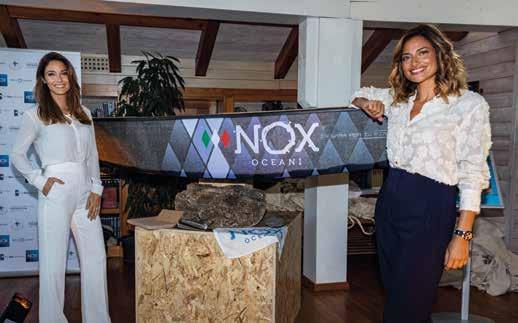
The beginner’s boat par excellence, countless champions and sailing enthusiasts alike have experienced the Optimist, albeit in passing. Now, Nox Oceani has created an eco-sustainable version of the same ubiquitous design.
“With this boat,” explains Francesca de Natale, president of Nox Oceani, “we want to accustom the next generation to the concept of eco-sustainability and the importance of protecting the world we live in, and also demonstrate that it is possible to build the same boats with different materials.”
Nox Oceani is an amateur sports association based in Sardinia that trains young sailors, with the aim of bringing together a passion of sailing, social commitment and respect for the environment.
The start-up Nox Oceani Innovability was founded alongside the association with the objective of not only massproducing an eco-friendly Optimist but also exploring eco-sustainable solutions across the nautical sector.
The boat itself is made of basalt fibre, a high-performance material
with excellent mechanical and physical properties that is also recyclable, combined with organic resins; this cuts the use of fibreglass and the complexities of its disposal.
The boat is also lined with cork while a bio-foam, a material similar to polystyrene but without an environmental impact, is used to give the hull its structure. Even the ropes, supplied by Armare, are made using recyclable materials.
“Our Optimist,” points out Francesca de
The start-up Nox Oceani Innovability was founded alongside the association with the objective of not only massproducing an eco-friendly Optimist but also exploring eco-sustainable solutions across the nautical sector. To side, Nox Oceani President Francesca de Natale Sifola Galiani (right) and Vice-President Rebecca Vespa Berglund
Natale, “once it reaches its maximum use and has succeeded in entertaining young sailors, can be recycled and transformed into various new objects. The challenge now is for this boat to be “accepted” by the International Optimist Dinghy Association (the current class regulations of which do not allow for hulls made with these materials) and allowed to race alongside other Optimists. And, who knows, in time even replace them.
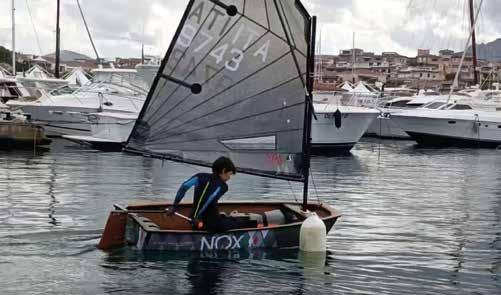
Knowing to what extent microplastics have infected the sea and understanding their impact on the ecosystem are key to determining an effective course of action to protect the marine environment. This defining objective is at the heart of the pilot project carried out in Italy by Suzuki, the Anton Dohrn Marine Biology Centre and the Porto Cesareo Marine Protected Area. In order to do so, Suzuki has provided its DF140BG outboard engine equipped with a #lavalacqua (Suzuki Micro Plastic Collector) system to monitor microplastics
in the sea. By using a specifically designed filtering device located inside the engine’s cooling circuit, the #lavalacqua system passively collects and separates microplastics as the boat moves across the water.
Collecting similar samples is normally a laborious and time-consuming task yet with the provided outboard, 2,400 litres of water can be filtered in just one hour. During the pilot stage of the project, however, the use of the outboard motor has been flanked by more traditional sampling techniques, a manual approach
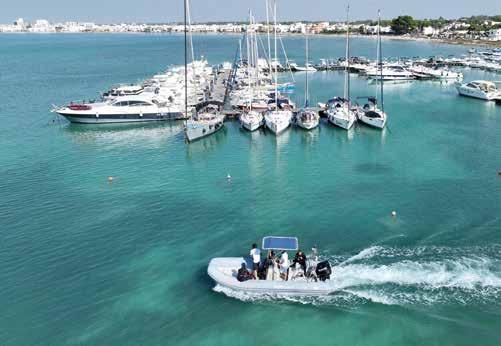
Organised by the One Ocean Foundation, the second edition of the Blue Economy Summit was held in early June, a day dedicated to the oceans and their preservation.
Hosted in Milan’s prestigious Bocconi University, experts from the worlds of academia, economics, finance and civil society gathered in the institute’s Roentgen Aula Magna lecture hall
that enables researchers to supplement the data obtained from classic Marine Strategy methodologies.
The first results have already been analysed by the Anton Dohrn Marine Biology Centre and show that 171 hours of operation collect 0.17 particles of plastic per cubic litre of filtered water. The items found are essentially fragments and films consisting mainly of polyethylene (70%) and polypropylene (25%).
What truly makes this project stand out is the fact that, if this experience does in fact yield productive results, the process will be able to be replicated worldwide, following a citizen science approach that could see boating enthusiasts helping monitor microplastics simply by going out to sea.
Suzuki has provided its DF140BG outboard engine equipped with a system to monitor microplastics in the sea
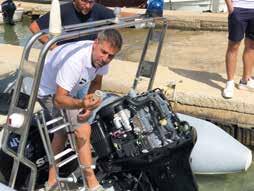
to discuss the current state of the oceans: our “natural blue capital”. Key discussion points included the importance of developing a robust Blue Capital Market, the evolution of innovative ocean technologies, the loss of biodiversity and the need for a more resilient water system, along with an analysis of the latest opportunities for the blue economy as a whole.
Automotive heavyweight Porsche and Austrian yard Frauscher have teamed up to produce the zero-emissions Frauscher X Porsche 850 Fantom Air. An exciting design complementing a technological heart, the boat includes the same components as the Premium Platform Electric (PPE) on which the new Porsche E-Macan is based, including the innovative permanently excited synchronous electric
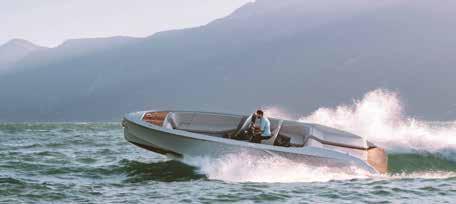
Amotor (PSM) with a maximum output of 400 kW. Construction of the prototype began back in 2022, using the Frauscher 858 Fantom Air as the project’s starting point, one of the yard’s bestselling models. Just like Porsche’s land equivalents, the model offers four driving modes - Docking, Range, Sport and Sport Plus. Each mode affects throttle response and imposes different speed limits. In Docking mode for port manoeuvres, for example, the speed is limited to 8 knots. “The electric version of the Fantom Air performed astonishingly,” explains Stefan Frauscher, managing director of Frauscher, “The boat outperformed its motor version in every driving characteristic, including top speed, acceleration and handling.”
The optimum cruising speed is 22 knots. This speed allows for close to an hour of use on a fully charged battery. The range at minimum cruising speed is over 53.9 miles. The maximum speed is reached in Sport Plus mode and has been limited to 46 knots.
pioneer of hybrid systems and among the first to use solar panels on board, Slovenian yard Greenline is celebrating 1,000 boats sold. Founded in 2008, the yard now fits its boats (ranging from 39 to 58 feet) with the sixth generation of its 6G H-Drive serial diesel-electric powertrain. A sustainable approach that goes beyond its engines. Greenline Yachts’ company philosophy of responsible boating also extends to its construction process. The high-tech foam sandwich used to reinforce the hull, for example, is derived from recycled PET plastic. Wood scraps from the interiors are collected and turned into pellets for heating, while leftover foam is reused by a neighbouring company to produce home insulation.
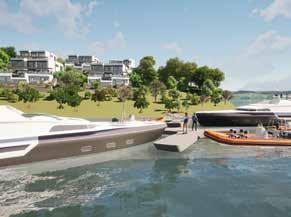

Specialising in electric solutions, eD-TEC is a leading company in marine e-mobility. Its global vision, however, goes beyond just boating, envisioning an interconnected future inspired by zero-emission living. After launching its high-performance eD-32 rib, eD-TEC presented a project for five extra-luxury waterfront villas in Croatia that will not only be 95% off the grid thanks to solar power generation and cutting-edge batteries for energy storage but will also come with their own eD-32 electric ribs. The villas, which will be built on Prokljan Lake in the Dalmatian region, are the first step in an ambitious project aimed at sustainable living and electric solutions, a project that will culminate with the creation of Croatia’s first Smart area, a CO2-neutral tourism destination.
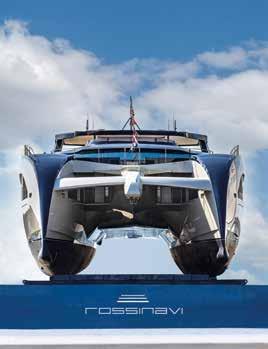
“
After years of planning and construction, we are proud to finally witness the launch of project Sea Cat, now Seawolf X, the first hybrid-electric multihull model” stated Federico Rossi, Chief Operating Officer of Rossinavi. The Seawolf X showcases
remarkable technological innovations in both power management and propulsion technologies, combining an attractive design with environmentally sound solutions.
“The Seawolf X marks the beginning of a new chapter in next-generation design” added the CEO. With exterior architecture by Fulvio De Simoni Yacht Design and interiors by the New York-based Meyer Davis Studio, the Seawolf X bears the Rossinavi BluE label and with it the yard’s new sustainable philosophy. Not only that, Rossinavi has also developed an onboard artificial intelligence system referred to as Rossinavi AI, designed to improve comfort and maximize the yacht’s green potential. The onboard AI constantly analyses operations onboard, acting as a central nervous system capable of learning through observation and predicting the needs of guests on board. The Rossinavi AI is always available to crew members, advising on how to minimise
Volvo Penta is set to replace the old combustion engines installed onboard the Crew Transfer Vessel Ginny Louise with a zero-emission solution. A green project dedicated to an existing boat makes for even greater circularity and sustainability, something that has helped make this project one of just 10 innovative developments awarded UK government funding as part of an industry-led transition towards net-zero. For t he Swedish company this will mark the first IPS application powered 100% by batteries and with no onboard diesel generators. The initiative will allow for an ultra-efficient set-up that will deliver longer-range and emissions-free transfers. The Ginny Louise, which after the retrofit will be renamed the e-Ginny, will be fitted with a quad installation of Volvo Penta IPS 30 paired with fully electric motors and over 2 MW of on-board battery capacity.
environmental impact and providing insights into conscious cruising. The result is a seamless tailored navigation experience. The AI software is also capable of monitoring the battery pack, maintaining its charge between 20 and 80%, the ideal range to ensure the battery pack lasts longer, while also supervising and interacting with the crew. Among the model’s more stand-out features, the cat can recharge at shore in just five hours and be used for one-day cruises without ever needing to disengage its full-electric mode. In fact, the Seawolf X can cruise in electric mode for 90% of the time on multi-day trips and for 80% of the time when cruising the Atlantic. The Hibernation mode, which kicks in when the cat is moored, reduces consumption to a bare minimum, returning the energy generated to the quay or private property. The Seawolf X can supply enough energy to charge an entire villa. (Désirée Sormani)
